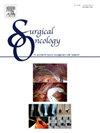Relationship between the distance from the tumor to major blood vessels and prognosis of deep soft tissue sarcomas
IF 2.4
4区 医学
Q3 ONCOLOGY
引用次数: 0
Abstract
Introduction
Recent reports show that vascular proximity on magnetic resonance imaging (MRI) increases the risk of local recurrence of thigh soft tissue sarcomas (STS). However, it remains unclear whether the defined radiological distance between the tumor and major blood vessels influences local recurrence-free survival (LRFS), metastasis-free survival (MFS), and overall survival (OS). We aimed to verify this association among patients with deep STS.
Methods
Clinical-pathological data of 149 patient's deep STS treated between 2014 and 2023 at a single institution were retrospectively analyzed. Based on MRI findings, the distance between the tumor and major blood vessels was investigated using two groups (“In contact” and “Not in contact”). Sex, age, tumor size, location, grade, AJCC staging, and distance to major blood vessels were evaluated using Cox proportional hazards regression models. Five-year survival rates were assessed using the Kaplan–Meier method.
Results
Median follow-up duration was 40 (interquartile range [IQR]: 19–75) months. The five-year OS, LRFS, and MFS rates were 72.5 %, 95.5 %, and 85.2 %, respectively. Multivariate analysis revealed significant associations between poor OS and tumor stage IV as well as “In contact” with major blood vessels. Additionally, the statistical significance between distant metastasis and “In contact” with major blood vessels was clarified.
Conclusions
A radiological “In contact” between the tumor and major blood vessels was a significant factor associated with poor prognosis and distant metastasis. Orthopedic oncologists should consider a treatment strategy based on the relationship between the distance from the tumor to major blood vessels on MRI preoperatively.
肿瘤离大血管的距离与深部软组织肉瘤预后的关系
最近的报道显示,磁共振成像(MRI)血管邻近增加了大腿软组织肉瘤(STS)局部复发的风险。然而,目前尚不清楚肿瘤与主要血管之间的放射学距离是否会影响局部无复发生存期(LRFS)、无转移生存期(MFS)和总生存期(OS)。我们的目的是在深部STS患者中验证这种关联。方法回顾性分析我院2014 ~ 2023年收治的149例深部STS患者的临床病理资料。根据MRI结果,采用两组(接触组和非接触组)研究肿瘤与大血管之间的距离。使用Cox比例风险回归模型评估性别、年龄、肿瘤大小、位置、分级、AJCC分期和到大血管的距离。采用Kaplan-Meier法评估5年生存率。结果中位随访时间为40个月(四分位数间距[IQR]: 19-75)。5年OS、LRFS和MFS分别为72.5%、95.5%和85.2%。多因素分析显示,不良OS与肿瘤IV期以及与大血管“接触”之间存在显著关联。此外,还明确了远处转移与大血管“接触”之间的统计学意义。结论肿瘤与大血管的放射学“接触”是导致预后不良和远处转移的重要因素。骨科肿瘤学家应根据术前MRI显示的肿瘤与大血管之间的距离关系来考虑治疗策略。
本文章由计算机程序翻译,如有差异,请以英文原文为准。
求助全文
约1分钟内获得全文
求助全文
来源期刊

Surgical Oncology-Oxford
医学-外科
CiteScore
4.50
自引率
0.00%
发文量
169
审稿时长
38 days
期刊介绍:
Surgical Oncology is a peer reviewed journal publishing review articles that contribute to the advancement of knowledge in surgical oncology and related fields of interest. Articles represent a spectrum of current technology in oncology research as well as those concerning clinical trials, surgical technique, methods of investigation and patient evaluation. Surgical Oncology publishes comprehensive Reviews that examine individual topics in considerable detail, in addition to editorials and commentaries which focus on selected papers. The journal also publishes special issues which explore topics of interest to surgical oncologists in great detail - outlining recent advancements and providing readers with the most up to date information.
 求助内容:
求助内容: 应助结果提醒方式:
应助结果提醒方式:


